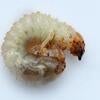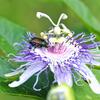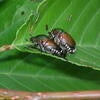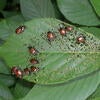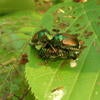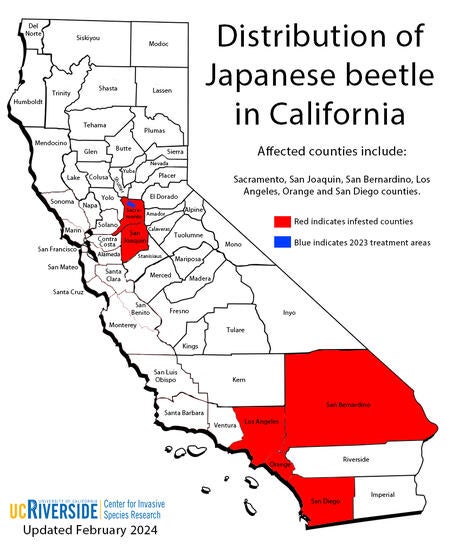Japanese beetle, Popillia japonica
The situation: The Japanese beetle (Popillia japonica, Coleoptera: Scarabeidae) is a highly destructive insect herbivore that has been reported to feed on more than 300 species of plants in wild, agricultural, urban, and recreational settings in North America, Asia, and Europe. Native to Japan, this invasive beetle has been introduced into several countries, likely through the importation and transport of nursery stock. In the US, it was first detected in New Jersey in 1916, likely following multiple earlier introductions. Currently, P. japonica has established widely or partially in 41 states, especially in the eastern US. Although it is not known to be established along the West Coast of the US, local infestations have been detected in the past, and its ongoing invasion is considered a threat to the region.
Identification, life cycle, and damage: Japanese beetle adults are small, approximately 10 to 15 mm in length, with metallic green bodies and brown wings. They should not be confused with other brightly colored scarab beetles, such as the green fruit beetle (figeater beetle), which are much larger and are endemic in parts of California. The life cycle of P. japonica generally consists of a single generation each year, the bulk of which is spent underground. Mated females burrow into the soil and lay upward of a few dozen eggs beneath the soil surface, often clustering them near plant roots. After hatching, larvae (grubs) feed on roots and underground stems of plants. Larvae are tan or yellowish in color and reach approximately 1 cm in length before developing into pupa. Adults, which emerge from late Spring through Summer, are gregarious and feed especially on leaves and blossoms.
Japanese beetle is reported to use more than 300 species of native trees and shrubs, fruit trees and vines, ornamental plants, vegetable crops, and grasses. Common hosts include several berries, stone fruit, grapes, legumes, corn, and turfgrass. Both larvae and adults can cause severe damage. Adults primarily feed on leaves, flowers, and overripe fruit – leading to severe skeletonizing of leaves and reductions in yield. Larvae feed on roots, especially in turfgrass, reducing the plant’s absorption of water and nutrients. Larval damage to lawns, parks, and golf courses can be severe, and likely accounts for a significant fraction of the estimated $450 million in management costs each year in the US.
Distribution: Native to Japan, the invasive distribution of P. japonica includes China and eastern Russia, much of eastern and central Europe, Canada, and the US. In Canada, it has invaded at least five provinces in the eastern part of the country. In the US, the rapid spread has made it difficult to create a consistent list of affected states. As of 2018, P. japonica was widespread in nearly all states in the eastern US and had established in portions of 8 additional states, as far west as Colorado. Statewide quarantines are in place to minimize the risk of introduction and spread in nine western states: Arizona, California, Colorado, Idaho, Montana, Nevada, Oregon, Utah, and Washington. Although P. japonica has been previously found in several of these states, it is considered to have been successfully eradicated. For example, infestations have been identified and subsequently eradicated in six California counties (see map). Most recently, in 2023, treatments were made by the California Department of Food & Agriculture (CDFA) to eradicate two localized infestations in Sacramento County.
Surveillance and management strategies: Given the difficulty and expense of managing Japanese beetle once it is established, preventive steps play an important role in mitigating its impact. These include surveillance and other efforts to disrupt accidental introduction of the beetle. Past introductions of P. japonica have been identified nearby airports, due to the beetle’s ability to efficiently “hitch hike” in the cargo hold of airplanes. As a result, airlines and shipping companies traveling to one of the quarantined US states from a location where P. japonica is widespread are required to adopt time consuming and costly surveillance and mitigation strategies to minimize the risk of introduction.
In areas where Japanese beetle is not widely established, surveillance and control measures will typically be conducted by local or state regulatory agencies. For example, in California, the CDFA maintains a statewide network of traps to identify new introductions. In the event of a new detection, additional trapping will occur in the surrounding followed by insecticide treatments in affected areas. Treatments consist of the application of a larvicide to turfgrass and select ornamental plants. In California, report suspected sightings of P. japonica to your county agricultural commissioner’s office or call the CDFA pest hotline (800-491-1899).
For areas where P. japonica is established, residents should follow recommended management guidelines. These include surveying for adults and grubs, applications of insecticides, microbial products (Bacillus thuringiensis), or entomopathogenic nematodes, and cultural controls such as removal of dropped fruit and modified mowing practices for turf.
Center for Invasive Species Research, University of California Riverside
Text provided by Matt Daugherty, Assistant Extension Specialist at University of California, and Hector Zumbado-Ulate
Distribution map created by Hector Zumbado-Ulate
Photos courtesy of Alfred Johnson and Nadeer Youssef, Tennessee State University
